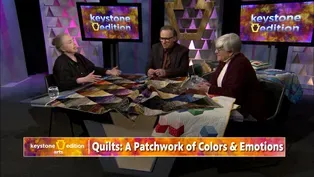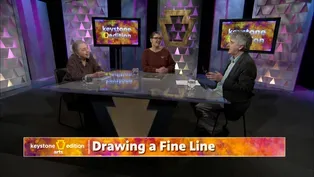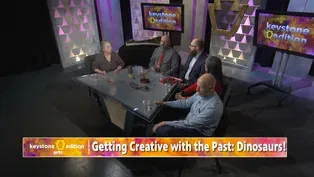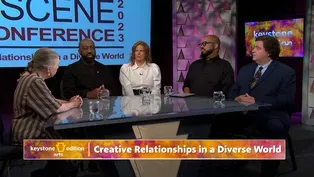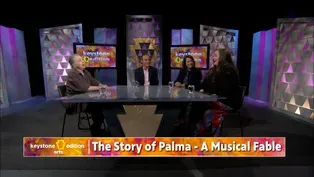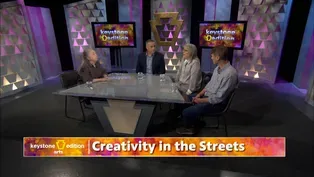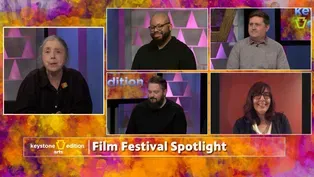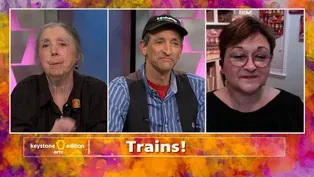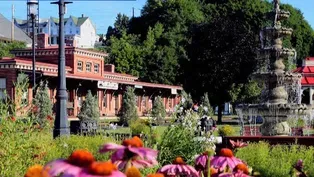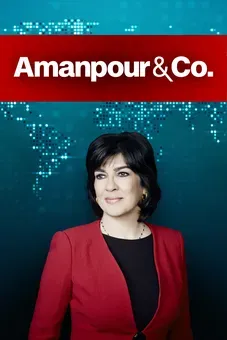Keystone Edition
Community Building Through Creativity
3/21/2022 | 27mVideo has Closed Captions
See how the people and organizations in Tamaqua improved their community's well-being.
Tamaqua, PA was one of three communities in the US featured in a 2021 report by the National Endowment for the Arts and the Kresge Foundation, for using arts and culture to improve social cohesion and community well-being. Watch Keystone Edition Arts to learn why social cohesion is important, and what the people and organizations in Tamaqua did to improve their community's well-being.
Problems with Closed Captions? Closed Captioning Feedback
Problems with Closed Captions? Closed Captioning Feedback
Keystone Edition is a local public television program presented by WVIA
Keystone Edition
Community Building Through Creativity
3/21/2022 | 27mVideo has Closed Captions
Tamaqua, PA was one of three communities in the US featured in a 2021 report by the National Endowment for the Arts and the Kresge Foundation, for using arts and culture to improve social cohesion and community well-being. Watch Keystone Edition Arts to learn why social cohesion is important, and what the people and organizations in Tamaqua did to improve their community's well-being.
Problems with Closed Captions? Closed Captioning Feedback
How to Watch Keystone Edition
Keystone Edition is available to stream on pbs.org and the free PBS App, available on iPhone, Apple TV, Android TV, Android smartphones, Amazon Fire TV, Amazon Fire Tablet, Roku, Samsung Smart TV, and Vizio.
Providing Support for PBS.org
Learn Moreabout PBS online sponsorshipMore from This Collection
Quilts: A Patchwork of Colors and Emotions
Video has Closed Captions
Quilts keep us more than just warm; they convey stories of family and cultural heritage. (26m 59s)
Video has Closed Captions
We invite you to learn about our region's past and present illustrators. (26m 59s)
Getting Creative with the Past: Dinosaurs!
Video has Closed Captions
What can we can learn by digging into the past with a creative mindset? (26m 59s)
Creative Relationships in a Diverse World
Video has Closed Captions
Creative Relationships in a Diverse World (54m 59s)
The Story of Palma - A Musical Fable
Video has Closed Captions
Get a behind-the-scenes look at the production (26m 59s)
Video has Closed Captions
Keystone Edition: Arts explores the past and present of the region’s murals (26m 59s)
Video has Closed Captions
We'll ask the WVIA radio hosts to share favorite memories (54m 59s)
Video has Closed Captions
We ask regional film festivals how they choose and what we can learn about filmmaking (26m 59s)
Playing Around: Sports and the Arts!
Video has Closed Captions
Keystone Edition: Arts asks what we learn when we look at sports through a creative lens. (26m 59s)
Video has Closed Captions
What changes for artists as they age? What benefits come from being creative while aging? (26m 59s)
Video has Closed Captions
Trains played an essential role in Pennsylvania's history and continue to fascinate today. (27m)
Inclusivity and Diversity in the Theatre
Video has Closed Captions
How can theatre companies attract more diverse cast members and audiences? (26m 59s)
Providing Support for PBS.org
Learn Moreabout PBS online sponsorship- [Announcer] Live from your Public Media Studios, WVIA presents "Keystone Edition Arts," a Public Affairs program that goes beyond the headlines to address issues in Northeastern and Central Pennsylvania.
This is "Keystone Edition Arts."
And now, Erika Funke.
- Welcome to "Keystone Edition Arts" where we'll celebrate the arts and community in Tamaqua, PA, and across the USA.
You're invited to take part by sending an email to keystone@wvia.org and on social media at #Keystonearts.
And we turn to Anne Gadwa Nicodemus of Metris Arts Consulting to provide a framework for our exchange.
(air whooshing) (gentle music) - Social equation, the definition that we arrived at is when individuals feel and act as part of a group that is oriented towards working together.
It's not necessarily good in and of itself, but social cohesion is linked to a lot of really great things like positive social, health and wellbeing outcomes.
So if you can improve social cohesion, it can be part of the process of helping communities achieve better and more equitable community wellbeing.
Communities that experience racism, oppression, or structural disinvestment, how can we help those communities leverage the disparities that they're seeing in terms of health and community wellbeing versus other communities?
I think it would be clearest if we kind of bring it home and talk about Tamaqua and use that lens to understand what is a pretty complex topic.
(gentle music) - Anne Gadwa Nicodemus of Metris Arts Consulting in Eastern Pennsylvania defining a key term for our discussion of the role the arts can play in fostering healthy communities.
Metris was the primary author of the recent report "WE-Making: How Arts & Culture Unite People to Work Toward Community Wellbeing" issued by the National Endowment for the Arts and the Kresge Foundation with Tamaqua in Schuylkill County as a featured example.
And we are very pleased to have among our guests.
Sunil Iyengar, Director of the Office of Research and Analysis at the National Endowment for the Arts, Micah Gursky, Executive Director of the Tamaqua Area Community Partnership, and Leona Rega, Executive Director of the Adams County Arts Council, formerly Director of the Tamaqua Community Arts Center, welcome to you all.
It's so good to have you with us.
Micah, I won't soon forget the question I asked you and the answer you gave in a radio interview.
I ask you why after spending time away in college you returned to Tamaqua, and you said, "It's like I never left."
What is so compelling?
What touches your heart?
Why are you so deeply rooted in Tamaqua?
- Sure.
And I think the answer partly goes back to what Anne was just talking about with social cohesion, where you feel like a connection to a sense of place, you feel like a connection or a social bonding with people.
It's my home.
It's where my family lives, it's where I grew up, it's where my teachers and coaches, my friends and a lot of people that I love and care about live there.
And I think that there's a lot of people who have that connection.
A lot of times people, we don't realize it until we leave and then you have a nostalgia for that home.
I don't know if I just always had that nostalgia, but I just enjoy my community.
It's not perfect, but it's where I live, it's where I raise my family, it's where I grew up.
And so, it's just something that really you feel part of.
- And yet you're a clear-eyed professional and you probably didn't need to have a Penn State study say that maybe the morale was a little low in Tamaqua.
So, tell us if you what about this critical study, this Penn State University study?
- Sure.
And I think that a lot of communities feel that too, but we actually had it documented and kind of put in our face.
And in 2011, Penn State did a study of a lot of communities in Pennsylvania.
And they talked about social capital and people feeling connected and whether they felt like their voice mattered and whether they felt connected to the community.
Like they were part of the decision-making.
And our report came back pretty negative and pretty dismal.
And a lot of the community development people and our chamber of commerce and a lot of the people that were actively trying to improve the community sort of took that as an insult.
Said, "Wait a minute, we try to get people involved.
And why don't people feel involved?"
And then we sort of stepped back and said, "Hey, maybe there's something to this and maybe we need to figure out why is it that people feel disengaged or they don't feel connected or they don't feel part of a group that's making decisions."
And so, we took a step back and tried to figure out if there was a way that we could get people connected and could get people's voices heard.
And so, yeah, it was a pretty dismal picture of our community.
- But it's not as if you hadn't been doing things as a community.
You'd been doing bricks and mortar as you say, right?
- Yeah, we were doing a lot of projects.
We were doing a lot of things that many communities do.
Trying to fill up our industrial park, trying to fix up our downtown, maybe build some parks and improve some recreation opportunities, preserve some of our historic sites.
And we we thought we were pretty successful.
And even outside opinions said, "Hey, you're doing what you set out to do."
But what we realized was doing all those projects didn't really accomplish everything that we wanted to accomplish if it didn't involve people and if people didn't feel a connection to it and didn't feel like they were part of the process.
- Well, Leona, welcome to you.
You are a native of Tamaqua too.
And when you were stepping down from your position as Director of the Tamaqua Community Art Center after eight years, we understand you told News 13 that your work at the center was a labor of love and that it came directly from, here's that word again, "Heart is so important in Tamaqua.
Came from my heart.
And it wasn't done alone.
It was done with all of you."
And you said, "I just want to encourage everyone everywhere to grab onto things you're passionate about and go forward with them.
And don't look back because forward is where you want to be."
So, you like Micah feel very deeply about your hometown.
These arts initiatives in Tamaqua took place before the NEA report.
How did they come together with the situation we just talked with Micah about?
- Really it's very interesting to have this report kind of put some terminology to the work that we did because when we were doing it, we just knew what we needed based on the report that had come out.
We knew that our community was at odds with itself and yet it loved itself when people were in need that they would come together for one another, but there were some real deep issues.
And so, I think being able to give people a voice through our letter writing campaign and letting people just open and honestly talk about what it was that they felt good, bad, ugly, positive, we wanted to draw that out.
We wanted people to talk about it so that we could then look at it, analyze it and start to work on it.
- And tell us if you would please how that idea for Dear Tamaqua, the letter writing came about.
Micah, Leona, either one of you.
- It was Micah's vision that we would do something in the community.
He had brought to me a Ted talk and he said, "I want you to watch this Ted talk where people are coming out on the streets, out on the fronts of their lawns and they were as a community, they were doing something together that they might not otherwise have done together."
And so, after the Ted talk, we had an inspiration to do something in Tamaqua.
And so, we had worked with Touchstone Theater at Bethlehem and together with their guidance began the letter writing campaign.
- Wow, that's wonderful.
And greetings, Sunil.
Thank you so much for being with us - Hello.
- and helping us put Tamaqua's experience into a larger context.
The preface when we read it of the "WE-Making" report describes the research involving what we've heard from Micah and Leona and two other communities as breaking new ground.
Can you tell us how that's so because there were senses all along that the arts could do this, but what was so special about this particular study?
- Well, I will say that although even further and say, even outside of this area, of course, all around the country maybe for years, perhaps even a few decades, certainly at least a couple of decades, really enterprise and communities have been rallying around the arts and bringing them to bear on social cohesion and allowing agency voice, expression of the community's potential to really prosper and prevail.
And it's wonderful because the report itself working with, and we saw it earlier and spotlighting Tamaqua was wonderful because we were looking for the root cause and how is it that in fact this works.
How does a complex ecosystem, if you will, of the arts, how does that work on a place level in a particular place in terms of cultivating social cohesion?
And so, we try to find a through line and understand how it was working in various communities around the country.
And so, the work of this conceptual framework report puts forward really gives organizations around the country a tool to try to make this happen in their own backyard.
And only just say quickly, it's not only about going in and kind of creating art or putting art where art wasn't.
It's about activating arts and cultural assets within the community and allowing communities to bind around those assets.
And Tamaqua does that wonderfully.
And so, we just try to elevate this and say, "Here's something great happening, folks.
Let's try to make this happen in more places around the country: urban, rural, big cities, small cities."
And we're hopeful that the report will help to get the word out and provide a toolkit for organizations and citizens to do this work.
- And picking up with what Sunil just said, the idea is that it wasn't just Dear Tamaqua and you built two years and you had a festival, but you've also had a succession of a events like this.
And what Anne whom we heard at the start suggested was that it's rooted in the community.
Leona, it's in the center itself as our focus and then the coffee house as well.
- Yeah, really it's involving the community, but we actually take these community art projects out into the community.
We don't sit in the art center and wait for people to come in.
And we actually go out into the street.
Recently we created a mural together where it was collectively painted and things like that.
And that engagement where we're meeting people where they are with the arts is really powerful.
It empowers the people to talk about what they might not otherwise talk about, they say things that they might not say at a borough or a city council meeting, they engage with each other and they really express themselves differently.
And it could be pretty scary for a community to openly ask, "Tell us what you think.
Express yourself."
That could be a very scary thing to do, especially if you know that there's gonna be some negative things out there.
So, we were very conscious to make sure that we were like, we want to hear it: the good, the bad, the ugly.
I think Leona said it.
We want to hear what your real thoughts are, what your dreams are, what your aspirations are, what your memories are.
We wanna hear all of it.
And really and by doing that purposely in a collective way, it really helped people connect with each other.
- Yes.
And Leona, in that case then, you had the walk, not just down the main street, but the alleys where it might be a little darker and a little scarier for people 'cause they may be experiencing some negative comments, but it was good in that way.
But you've observed each of you that the fact is that these initial efforts on the part of the community were looking at the past and maybe the present, but you noticed that there weren't so many comments about the future.
Were you involved in Raw Aspirations, Leona or did that come after?
- The Raw Aspirations was actually our third project because after Dear Tamaqua, we had volunteers in the community who worked with the art center during Dear Tamaqua that were mobilized to want to do a project called Tamaqua's Heart.
And then from there we did Raw Aspirations.
So, Raw Aspirations was the third project.
And again, it was being out in the community.
It was working not just within our own town, but we started to work a little bit more regionally with art centers outside of Tamaqua directly, but still within our county.
- Sunil, you are a research and analytics fellow and you would very much appreciate the fact that Tamaqua had a before study from Penn State - Yes.
- and they shook Penn State University and said, "Come on back.
We want you to look at the after."
What does that do for a study like this when you have data?
- Well, it's a shot of adrenaline in the sense that for community members to really go back and get the researchers involved and interested again is a big feat.
So hats off, first of all, the group that made that happen.
They're at Tamaqua because a lot of times researchers will swoop in and do the study and go away.
And what we really do need is more of that kind of activism to kind of get engaged with the research community through the arts and get them on board and chronically these great developments.
And I will say this that for a long time, people who advocate for the arts and talk about the value of the arts in policy circles tend to stress things like the economics of the arts or we care about that or the arts' benefits for education.
And we care about that as well.
And we've studied those things and we have fairly good data on those kinds of aspects, but to really go in and understand how the arts can leverage or can rather contribute to community health in a very measurable way as you said for the pre and post kind of study is really another thing altogether.
And we're now the NEA going forth with a bold research agenda to try to attempt to understand that better, the community dynamics of arts participation, of arts engagement and how that can lead to community transformation, revitalization.
And of course, we need that at this present time.
Certainly over the height of the pandemic, we were all kind of hunkered down and with a lot of energy thinking about community health and public health and how the arts relate to that.
So there's a lot of great research to support that.
I want to quickly say other sponsors of the study included the Robert Wood Johnson Foundation, which of course does a lot of work around public health.
- Oh, yes.
- So, that itself attests to this potential value.
- Well, that's a very good point.
And we want to maybe follow up with you a little bit about another partner that you work with in Florida too if we have time for that.
But Leona, you spent eight years and you were involved on the ground in this work.
And I wonder if now as the Director of the Adams County Arts Council in Gettysburg, if you've been thinking about what you'd experienced in Tamaqua and how it might come into play where you are newly?
- I have.
Gettysburg is known for its history and for the key role that has played in the United States, but there were people that lived here before the Battle of Gettysburg.
And so just like Tamaqua, there are people who are struggling with their identity and who they are as a community and what do they want to be known for and how do they wanna be remembered beyond the battlefield?
And so, when you take the entire collective of the community, I started to reflect about what we had done in Tamaqua and how we were able to hear those voices.
And so, the pandemic has kind of slowed those initiatives down a little bit, but we are working on very similar types of methods where we're going out and asking the community to talk to us about what's important to them or what is it that they feel that they want to explore about themselves.
And so, we do have a project that's called the People Project, and we've asked the community to come together and pick a theme.
And so, we kind of at this moment have it narrowed down to five themes that they have until Friday to decide which theme that they'll pursue, but it'll be a very, very similar process that we did in Tamaqua just done a little differently.
- And you were smilling broadly Micah when she was describing that.
- Yeah, I think it's wonderful and I think it's a really good example of how any community can do this.
Tamaqua is a small rural coal mining community.
You don't need to have a big research part of this.
The WE-Making framework really lays it out what sort of elements you need to have as part of a project that's going to accomplish this and how it will build trust if you follow this format.
And so, I think it's great that Gettysburg is doing that.
And I think a lot of arts organizations and communities that rely on the arts to sort of have these kind of conversations.
We like to think that they work and that there's an impact.
And we like to present the funders that it's gonna work.
And sometimes when you look behind, you're kind of fuzzy on the data.
Does it really work?
So, if you can couple it with some research or even a before-and-after survey or something from your community, then you could have some data that you can go to the National Endowment for the Arts or other funding agencies and say, "Hey, look, this really did work And we'd like to do more of it."
- Yes.
And you have told me in that famous radio interview that we did that you even before the NEA report had been contacted by other communities around the country who got wind of what you all were doing.
So, it is very much people in the arts are curious about what's successful.
And I go to you Sunil because you have a partner at the University of Florida, and they have a website with examples.
Tell us about that.
- Yeah, there's a great.
So, we actually also fund them on another project, but it's the Center for Arts and Medicine at the university of Florida.
And they've done some great work as a center in terms of understanding and really collecting and presenting evidence supporting the arts in medicine and health.
They've done work with the CDC around vaccine readiness and using the arts to engage people around that.
And with us, they're actually doing studies to understand the long-term benefits of the arts in terms of arts participation with variety of different cohorts: young adults, older people and what kinds of health outcomes are associated with arts participation 'cause one of the things we have to understand is we're talking about healthy lifestyles too.
And I think when we talk about the arts in the social cohesion context or health context, some of the best research we have is about the individual-level benefits of the arts on people's wellbeing, emotional wellbeing and even some preventative effects we're seeing.
And so, I think what Center of Medicine in Florida has done is focused on that, but also brought it into a public health context and really understood how communities like Tamaqua and others are taking the arts and using it very intentionally to improve public health outcomes.
- And you work in public health as well, Micah, so you can understand how that works.
- Yes, absolutely.
I'm a rural health clinic administrator in Tamaqua.
And I can tell you it's a lot more fun to do an arts project that builds social cohesion and improves people's happiness and connection and a sense of purpose and brings good health outcomes.
It's much more fun to work on that side of it than it is to deal with depression and chronic disease and substance use disorder, alcoholism, drug use, blighted properties, all of the negative things.
And a lot of times in communities, we focus on those.
On addressing the negative parts.
Really this WE-Making that can actually impact not just an individual's health, but a collective health in a community it's a lot more fun to work on.
(laughs) - I'm sure.
And Anne also gave us some thoughts.
You all have spoken broadly and wonderfully about why this works.
And Sunil, you said there's more work to be done in examining why that is so with the arts.
But Anne Gadwa Nicodemus who is of Metris Arts Consulting in Eastern Pennsylvania was speaking with us by Zoom and she had some thoughts about what it is.
And she sort of laid them out for us in a summary way.
(air whooshing) - We still have to ask, "So what?
Social cohesion to what end?"
And in our model, we explore how social cohesion can enable coordinated community organizing and activity and lead to increased equitable community wellbeing.
So I know that's a mouthful again, but if you just make it concrete with Tamaqua, subsequently they developed large scale public art events that aim to move from voicing the past towards developing a community-driven vision for the future in which residents work together to achieve a common goal.
So they developed shared values, they increased collective efficacy, they took collective action.
So this project really laid the groundwork for people to be able to work more effectively together to articulate and realize the change that they wanted to see.
- Thank you, Anne.
And there's a mural that we saw at the start and we might see it at the end.
And it's a train, it's a standalone mural.
And it's a train track around the edge and there's an engine.
There it is.
And it reaches.
The train is almost at this renewed, wonderful historic train station.
And it reminded me and probably maybe others of that little train that could, "I think I can, I think I can."
And it's seems like the train is on the track and it's going to reach its destination.
What did that come out of that mural and what does it suggest?
- Well, that mural just like everything from the Dear Tamaqua Project came from the words of the people who submitted letters as part of that art project.
And so, what we did was we took the words and feelings and memories and images that people talked about or shared with us and Leona and her team converted it into a shared community festival, a shared experience.
And they were good ones like renewed determination.
There were also some negative ones.
There was another sign that said burn it down.
And what was powerful about this was that we were able to deal with the negative and the positive, acknowledge both of them because we often have community members who are either completely negative or really completely positive.
And neither one of them is really true about any community.
Certainly not ours.
And so, that renewed determination is just an acknowledgement that somebody in our community thought that one of the things that's special about Tamaqua is that we're determined.
We're determined to save our train station or the Owl Creek Reservoirs or the other resources that we have.
And then when we run out of steam, we renew it again and we're still determined to improve the community.
So, we had some very uplifting pieces that came out of it.
- And Sunil, we know that the other communities in addition to Tamaqua, East Oakland, right?
So that's urban.
And Natchez?
- Natchez, right.
Absolutely.
- Yep.
So, you got a real balance there, didn't you?
In terms of- - Yeah, we did.
And it's maybe an opportunity for me to say that the NEA supports this kind of work around the country through a program called Our Town.
It's a grants program that does essentially what's called creative placemaking.
I sometimes called it also creative place keeping because there're communities that have already have cultural assets as we know in place.
It's not always that they're making new things, but it is providing that connective tissue between artists, designers, local government to really foster a community through the arts.
Whether it's redeveloping a waterfront or creating public art or what have you, and certainly in the arts and design of the place.
And so this, again, this report helps us to through these cities that we've profiled and through Tamaqua, shows us how it can be done elsewhere and how also to what end as Anne said.
- (indistinct) said.
Yes.
- Social cohesion, but in a way that's going to uplift and elevate voices within a community.
And one of the great things I heard about from Micah is just this concept of holding nuanced discourse and having dissenters even among the people within a community who helped to create that community and allowing them a voice as well.
I think that's really important this time when we're all striving for greater equity.
- And the wonderful conclusion of the Dear Tamaqua Project, you came together and you had the walk and you had the wonderful displays of the artists, actors reading the words of people.
And yeah, (man speaks faintly) it was wonderful fireworks.
Leona, as we close, you may be surprised by this and may not be able to say, but you remember JP Jordan singing his anthem in the square with the fireworks, Dear Tamaqua.
Either of you, (Leona speaks faintly) what did that Anthem capture?
Leona, what do you say quickly?
- Well, there was a sign that said lost our pride.
And I think in that culmination of a moment, we found our pride again.
I think as a community, we were able to look up and put our chins up and really just march forward.
And that's what I really wish for every community.
Is just to find that component and that piece that helps you to say, "We are proud to be who we are with our scars and with our rainbows, whatever it is that we have, but we can do this together."
(Erika claps) And I think that's how we felt.
- Thank you, Leona; thank you, Sunil, thank you, Micah.
Go to the WVIA website.
Thanks.
(gentle music)
Community Building Through Creativity - Preview
Preview: 3/21/2022 | 30s | Watch Monday, March 21st at 7pm on WVIA TV (30s)
Providing Support for PBS.org
Learn Moreabout PBS online sponsorshipSupport for PBS provided by:
Keystone Edition is a local public television program presented by WVIA
